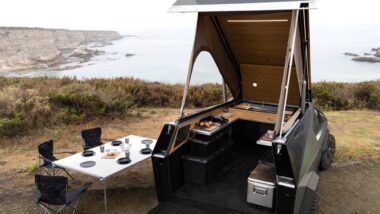Table of Contents Show
Have you ever felt a gust of wind thrash about your RV? This might occur in calm conditions when a semi-truck comes barreling past you.
It can be a scary feeling! But high winds are a whole other ball game. They should not be ignored when driving a high-profile vehicle like an RV.
Today, we’re looking at a new announcement by the Wyoming DOT to keep drivers safer and prevent accidents. We’ll also discuss why driving in windy conditions is so dangerous. Let’s dive in and learn more!
Wyoming DOT Enforcing Changes To Keep I-80 Safer
At the end of October, the Wyoming DOT announced it would begin adding weight restrictions to wind warnings on I-80. This interstate runs through the southern part of the state from Evanston in the west to Pine Bluffs in the east.
If you’re traveling along I-80 or other blow over hot spots in the state this winter, you’ll likely see updated weight-based wind closure messaging to keep drivers safe. I-25 and Wyoming Highway 28 are other major roads with repeated high-profile vehicle blow overs.
These safety precautions have come after recent research from the University of Wyoming. Drivers of high-profile vehicles that weigh less than a certain amount will be restricted during high winds.
For example, on October 26, 2023, the Wyoming DOT’s 511 map highlighted the westbound route between exits 279 and 290 with the warning “Closed to light and high profile vehicles due to WBC 50; extreme blowover risk. All enclosed trailers under 50,000 GVW are restricted.” While this may limit the transportation of goods, it’s critical to keeping those drivers and others on the road safe.
Your Insurance Could Not Pay If You Had an Accident With Wind Warnings
One Facebook user posted about this recent change in a full-time RV living group. He shared a trucker’s post warning drivers to heed these restrictions.
If lightweight, high-profile vehicles are involved in an accident in a restricted area, insurance companies will likely not pay.
That’s money coming out of your pocket, which could total thousands and thousands of dollars. Don’t risk it. Wait out high wind events for your own safety and the safety of others.
What Is Considered High Winds?
If winds have sustained speeds of 40 to 57 miles per hour, they’re considered “high winds,” according to the National Weather Service.
The agency explains that these conditions can cause small branches to break off trees, loose objects to blow around, isolated power outages, and damage to porches, carports, awnings, or pool enclosures. High winds are dangerous for high-profile vehicles and boaters on area lakes.
Why Is It Dangerous To Tow In High Winds?
If you do a lot of traveling around the country, you’ve likely encountered windy conditions. Driving in 20-25 mile per hour winds is pretty common. But even in low winds, gusts can frequently occur above 35 miles per hour.
We’ve white-knuckled it through some areas where we could feel gusts pushing against our RV. We’ve definitely pulled over because we just didn’t feel safe.
This is always best when driving or towing a high-profile vehicle. A single gust can topple RVs and semi-truck trailers because they have a large surface area.
You could also lose control as the wind pushes against your RV. This isn’t safe for you or the other drivers on the road. If you ever feel like you’re not in total control of your vehicle, you need to pull over immediately and wait it out.
Plus, anxiety and stress aren’t positive additions to a drive day. White-knuckle driving can lead to impatience with your passengers, increased exhaustion, and poor decision-making. Because winds are so dangerous, we highly recommend paying attention to the weather forecast days before your travel so you can plan accordingly.
What Should You Do If High Winds Are Forecasted?
We suggest leaving a day earlier or a day later to avoid high winds. This is the beauty of RVing. Flexibility is key for safe travel. Start looking at the weather forecast three or four days before your travel day. If high winds are forecasted, change your route or the timing of your drive.
If you’re traveling in Wyoming, where the DOT implemented restrictions, you won’t be permitted to continue your route anyway. You might as well enjoy another day at the campground to travel in safer conditions.
Tips For Driving In Windy Conditions
Sometimes, you can’t avoid windy conditions. When you encounter moderate winds or gusts, we have a few tips to help you stay safe.
First, how you distribute your weight makes a difference in the ride. Load up your cargo over the wheelbase of the RV to prevent sway.
Second, drive slower. RVers should always leave plenty of room to stop and drive at a speed where they feel in control. Windy conditions will have gusts that may catch you by surprise. To reduce their effects, go slower to maintain control when they occur.
Finally, pull over if you feel unsafe. Don’t push through or add to your anxiety. This isn’t healthy for you or your passengers and potentially hazardous for other drivers. You can check out our tips for safe driving in windy conditions to ensure you’re safe when the wind hits.
Other Weather Conditions To Avoid When RVing
While high winds are one weather condition to avoid because of the high-profile design of RVs, you’ll also want to check the forecast for other possible dangerous situations.
Rain and snow can affect the road surfaces and cause low visibility. Tires don’t get as much traction, and drivers struggle to see what’s in front of them, leading to dangerous consequences.
Fog is another weather condition that many people don’t consider when RVing. According to the U.S. Department of Transportation, fog causes over 38,700 vehicle crashes and more than 16,300 injuries annually. If you can’t see far enough in front of you to feel safe, pull over and wait it out.
Finally, always heed the warnings for extreme weather like tornados and hurricanes. Know the areas of the country where these weather events tend to occur.
For example, if you’re traveling through Texas in the spring, download local weather apps and stay informed about current and future conditions. We suggest every RVer have a NOAA emergency weather radio.
- MULTIPLE POWER SOURCES – The ER310 features 3 sustainable power sources to recharge your radio: Solar Panel, Hand Crank,…
- EMERGENCY FLASHLIGHT – The SOS FLASHLIGHT BEACON flashes Morse code in an emergency scenario and the Bright CREE LED…
Stay Safe In Dangerous Weather Conditions By Changing Your Travels
RVing is supposed to be fun. Travel days are already stressful enough. Don’t add to your anxiety by attempting to drive in high winds. Your destination will still be there a few hours or a day later.
Whether you’re traveling along I-80 in Wyoming or I-95 in Florida, heed the warnings, obey the posted restrictions, and arrive safe and sound.
What do you think about the new system the Wyoming DOT is implementing to keep drivers safe?
Last update on 2025-01-19 / Affiliate links / Images from Amazon Product Advertising API







